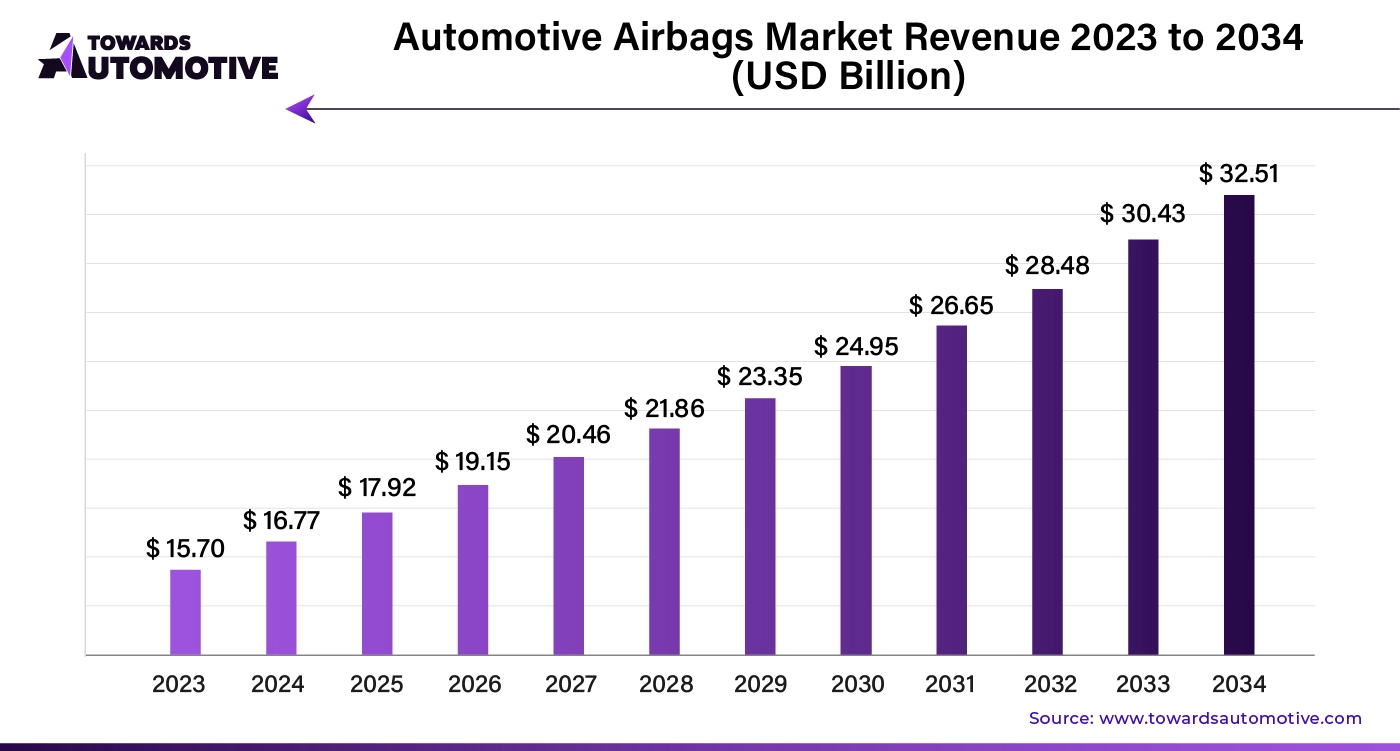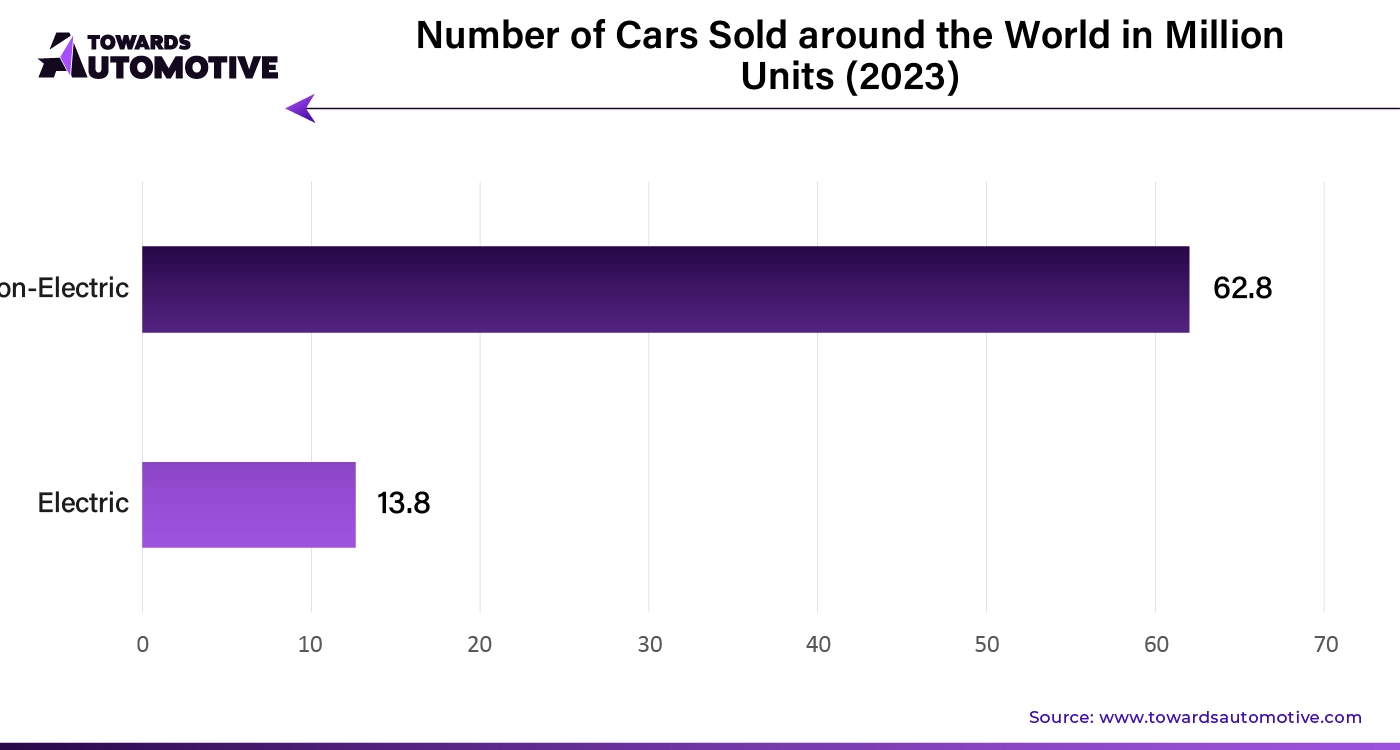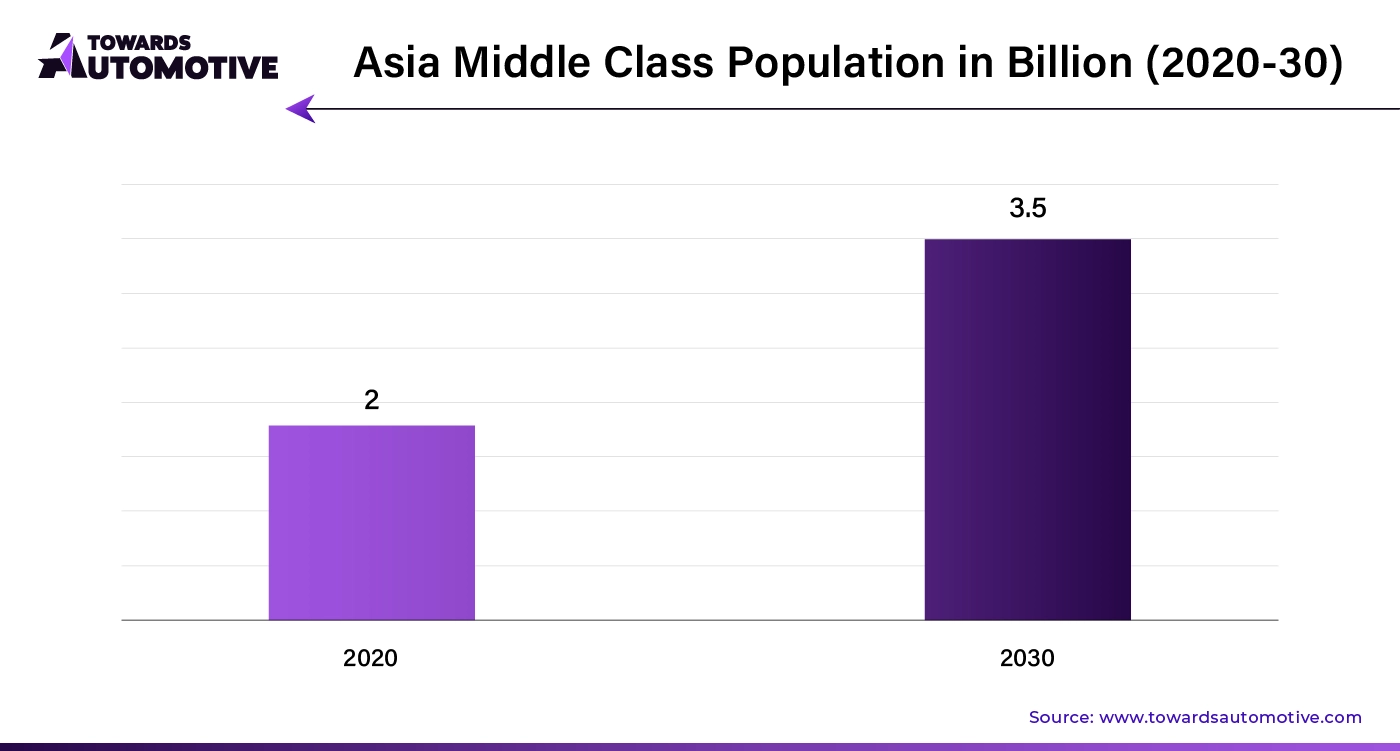April 2025
The global automotive airbags market size is calculated at USD 16.77 billion in 2024 and is expected to be worth USD 32.51 billion by 2034, expanding at a CAGR of 6.84% from 2024 to 2034.

Unlock Infinite Advantages: Subscribe to Annual Membership
The automotive airbags market is growing rapidly, driven by increasing vehicle safety standards, regulatory requirements, and rising consumer awareness about the importance of safety features. Airbags, which act as a critical passive safety system, are designed to inflate instantly during a collision, providing protection to occupants by reducing the impact of the crash. As the global automotive industry continues to expand, especially in emerging markets, the demand for advanced safety technologies like airbags is rising. Governments worldwide are enforcing stringent safety regulations, requiring the inclusion of airbags in vehicles, which is further fueling market growth.
Technological advancements in airbag systems, such as the development of smart airbags that can adjust inflation intensity based on the severity of the collision or the size of the occupant, are contributing to the market’s evolution. Additionally, the growing adoption of side, curtain, and knee airbags alongside traditional front airbags enhances occupant protection, driving further demand.
The increasing production of electric vehicles (EVs) and autonomous vehicles is also creating new opportunities for airbag manufacturers. These vehicles require advanced safety systems to meet evolving safety standards, especially as they become more integrated with driver-assistance technologies. As consumer demand for safer vehicles continues to rise and automotive manufacturers focus on innovation, the automotive airbags market is expected to see sustained growth. The market is poised for expansion, with manufacturers investing in new materials, designs, and technologies to enhance the efficiency and performance of airbags.
Artificial Intelligence (AI) plays a transformative role in the automotive airbags market by enhancing the efficiency, precision, and adaptability of airbag systems. AI-powered sensors and algorithms are increasingly integrated into modern airbag systems, allowing them to make real-time decisions based on data collected from the vehicle. These intelligent systems can detect the severity of a collision, the position and size of passengers, and other critical factors to deploy airbags more effectively and safely.
One of the primary benefits of AI in this market is the development of "smart airbags." These systems use AI algorithms to assess crash dynamics, adjusting the inflation rate and intensity of the airbag to minimize the risk of injury. For instance, AI can determine if an occupant is a child or an adult and tailor the deployment accordingly, reducing the risk of airbag-related injuries.
AI also contributes to the integration of airbags with other safety technologies, such as Advanced Driver Assistance Systems (ADAS). In scenarios where AI detects an imminent collision through systems like automatic emergency braking or lane-keeping assistance, it can preemptively prepare the airbag system to respond faster and more efficiently. Furthermore, AI enhances post-collision data analysis, helping manufacturers improve the design and deployment mechanisms of airbags based on real-world crash data.
By leveraging AI, the automotive airbags market is moving toward more intelligent, adaptive, and reliable safety systems, improving overall vehicle safety and helping meet stricter global safety standards.
The rising sales of cars are a major driver of growth in the automotive airbags market, as increasing vehicle production naturally boosts the demand for safety features like airbags. As more consumers purchase cars, especially in emerging economies where car ownership is expanding rapidly, the need for safety systems becomes more prominent. In many regions, government regulations mandate the inclusion of airbags in all vehicles, and the rising volume of car sales translates into a direct increase in the demand for airbag systems.
Additionally, as consumers become more aware of vehicle safety and prioritize it in their purchasing decisions, manufacturers are incorporating more advanced airbag technologies in their vehicles. The growing trend of equipping cars with multiple airbag systems—including front, side, curtain, and knee airbags—further fuels market expansion. Premium and mid-range vehicles are increasingly offering these advanced safety features as standard, while budget vehicles are also upgrading their safety standards to remain competitive.
The growth of electric vehicles (EVs) and autonomous vehicles is also contributing to the rise in automotive airbag demand. These new-generation vehicles require more sophisticated safety systems, including enhanced airbag protection, to ensure occupant safety in new crash scenarios specific to EVs or self-driving cars. As the global car market continues to expand, the automotive airbags market is expected to grow alongside it, driven by the increasing importance of safety, regulatory requirements, and consumer demand for protection on the road.

The automotive airbags market faces several restraints that hinder its growth. High costs associated with advanced airbag systems, such as multi-airbag setups and smart airbags, can limit their adoption, especially in budget vehicles. Additionally, recalls and failures due to faulty airbags, such as the Takata airbag crisis, have raised concerns about reliability and safety, negatively impacting consumer trust. Stringent testing and regulatory compliance requirements also increase production costs, creating barriers for manufacturers to innovate and offer affordable, advanced airbag solutions across all vehicle segments.
The development of multi-airbag systems is creating significant opportunities in the automotive airbags market by enhancing vehicle safety and driving consumer demand for advanced protection features. Multi-airbag systems, which include front, side, curtain, and knee airbags, provide comprehensive protection to occupants in various types of collisions, such as side impacts and rollovers. As safety becomes a higher priority for consumers, particularly in regions with stringent safety regulations, automakers are increasingly adopting these systems in both premium and mid-range vehicles.
The growing implementation of multi-airbag systems offers manufacturers the opportunity to innovate and differentiate their products, particularly in competitive automotive markets. By offering advanced safety features, automakers can attract safety-conscious buyers and comply with evolving safety standards. Additionally, these systems are becoming more sophisticated, with the integration of sensors and artificial intelligence (AI) that adjust deployment based on occupant position and crash severity.
As a result, the demand for multi-airbag systems is expanding, creating a favorable environment for airbag manufacturers and suppliers. The shift toward equipping vehicles with multiple airbags is expected to contribute significantly to the growth and evolution of the automotive airbags market, opening up new revenue streams and market opportunities.
The frontal airbags segment held the largest share of the market. The frontal airbags segment plays a pivotal role in driving the growth of the automotive airbags market, as they are a standard safety feature in almost all vehicles globally. Frontal airbags are designed to protect the driver and front-seat passengers during head-on collisions, reducing the risk of severe injuries. With stringent government regulations mandating the inclusion of frontal airbags in passenger vehicles, particularly in regions like North America, Europe, and parts of Asia, the demand for these airbags remains high.
The rising global vehicle production, particularly in emerging markets, also contributes to the growth of the frontal airbags segment. As car ownership expands in these regions, the need for basic safety features, such as frontal airbags, increases significantly. Additionally, growing consumer awareness of vehicle safety is prompting manufacturers to equip vehicles with advanced airbags that offer enhanced protection.
Innovations in airbag technology, including adaptive frontal airbags that adjust inflation based on occupant size and crash intensity, further fuel demand. This segment's growth is also supported by the increasing adoption of safety technologies in budget and mid-range vehicles, making frontal airbags a key contributor to the overall expansion of the automotive airbags market.
The SUV segment dominated the industry. The SUV segment is a significant driver of growth in the automotive airbags market, as the global demand for sport utility vehicles continues to rise. SUVs, known for their larger size and higher center of gravity, tend to have different crash dynamics compared to smaller cars. As a result, they require advanced airbag systems for enhanced occupant protection in case of rollovers, side impacts, or front-end collisions. To meet these safety demands, automakers are equipping SUVs with multiple airbag systems, including front, side, curtain, and knee airbags, driving market growth.
In addition to safety, the increasing consumer preference for SUVs, particularly in markets like North America, Europe, and Asia, is contributing to the rising demand for airbags. As SUV sales surge, manufacturers are investing in advanced safety technologies, making airbags a standard feature across most models. This trend is further supported by stricter safety regulations and crash test requirements, which mandate the inclusion of comprehensive airbag systems in larger vehicles like SUVs.
As consumers prioritize safety alongside performance, the growing popularity of SUVs continues to drive the demand for advanced airbag systems, bolstering the overall growth of the automotive airbags market.
The others segment held the dominant share of the market. The others segment consists of clock springs, wiring harnesses, and others. Clock springs, wiring harnesses, and other essential components are key drivers of growth in the automotive airbags market, as they are crucial to the proper functioning of airbag systems. Clock springs are integral to steering wheel airbag deployment, allowing the airbag to receive electrical signals while maintaining a continuous connection between the steering wheel and vehicle electronics. As more vehicles adopt advanced airbags, the demand for durable and reliable clock springs increases, driving growth in the airbag market.
Wiring harnesses also play a vital role by connecting various electronic systems in a vehicle, including airbag modules, sensors, and control units. With the rise of multi-airbag systems and smart airbags that rely on sensors to assess crash conditions, the need for high-quality wiring harnesses has grown significantly. These components ensure that airbags deploy precisely when needed, enhancing passenger safety and boosting market demand.
Additionally, other supporting components like inflators and sensors are advancing in technology, making airbag systems more efficient and reliable. Together, the growth in demand for these key components is fueling the expansion of the automotive airbags market as automakers prioritize safety and innovation in airbag design.
Asia Pacific dominated the automotive airbags market. The growth of the automotive airbags market in Asia Pacific is significantly driven by the rising middle-class population, technological advancements, and growing awareness of vehicle safety. The expanding middle-class population, particularly in emerging economies such as India and China, is increasing the demand for personal vehicles with enhanced safety features. As disposable incomes rise, more consumers are able to afford vehicles equipped with advanced safety technologies, including sophisticated airbag systems, which boosts market demand.
Technological advancements are another critical factor propelling market growth. Innovations such as smart airbags, which utilize sensors and artificial intelligence to adjust deployment based on occupant size, position, and collision severity, are becoming more prevalent. These advanced systems offer superior protection and are increasingly being adopted in new vehicle models, driving the market forward. The development of multi-airbag systems, including frontal, side, and curtain airbags, further supports this trend by providing comprehensive occupant protection and meeting stringent safety regulations.
Growing awareness of vehicle safety is also playing a crucial role. As road safety becomes a priority for consumers and governments alike, there is an increasing emphasis on equipping vehicles with advanced safety features. Public awareness campaigns and education on the importance of airbags in preventing injuries during accidents are influencing consumer preferences, leading to higher adoption rates. Combined, these factors are driving the automotive airbags market's expansion in Asia Pacific, as the region continues to embrace safer, technologically advanced vehicles.

Europe is expected to grow with a notable CAGR during the forecast period. In Europe, the growth of the automotive airbags market is significantly driven by rising consumer awareness, a focus on electric and autonomous vehicles, and stringent safety regulations. As European consumers become increasingly informed about vehicle safety, there is a growing demand for advanced safety features, including airbags. Public awareness campaigns and educational initiatives highlight the critical role airbags play in reducing injury during accidents, prompting consumers to prioritize vehicles equipped with these essential safety systems.
The focus on electric and autonomous vehicles in Europe also fuels market growth. As the automotive industry shifts towards electric vehicles (EVs) and self-driving cars, new safety challenges and opportunities arise. Electric vehicles, with their unique design and battery placement, require specialized airbag systems to ensure occupant protection. Similarly, autonomous vehicles, with their novel seating arrangements and crash dynamics, demand innovative airbag solutions to address different collision scenarios. This evolution in vehicle technology is creating new opportunities for airbag manufacturers to develop and implement advanced safety systems.
By Type
By Vehicle Type
By Component
By Region
April 2025
April 2025
April 2025
April 2025
We offer automotive expertise for market projections and customizable research, adaptable to diverse strategic approaches.
Contact Us